
The Araceae are a family of monocotyledonous flowering plants in which flowers are borne on a type of inflorescence called a spadix. The spadix is usually accompanied by, and sometimes partially enclosed in, a spathe. Also known as the arum family, members are often colloquially known as aroids. This family of 140 genera and about 4,075 known species is most diverse in the New World tropics, although also distributed in the Old World tropics and northern temperate regions.

Arum maculatum is a woodland flowering plant species in the family Araceae. It is native across most of Europe, as well as Eastern Turkey and the Caucasus.
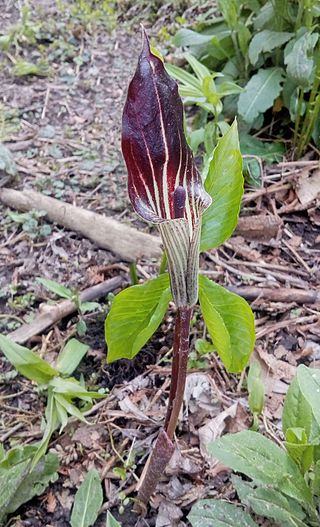
Arisaema triphyllum, the Jack-in-the-pulpit, is a species of flowering plant in the arum family Araceae. It is a member of the Arisaema triphyllum complex, a group of four or five closely related taxa in eastern North America. The specific name triphyllum means "three-leaved", a characteristic feature of the species, which is also referred to as Indian turnip, bog onion, and brown dragon.
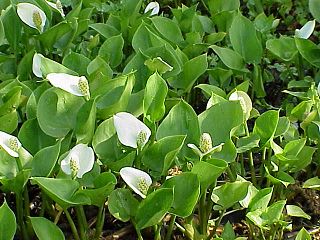
Calla is a genus of flowering plant in the family Araceae, containing the single species Calla palustris.

Arum is a genus of flowering plants in the family Araceae, native to Europe, northern Africa, and western and central Asia, with the highest species diversity in the Mediterranean region. Frequently called arum lilies, they are not closely related to the true lilies Lilium. Plants in closely related Zantedeschia are also called "arum lilies".
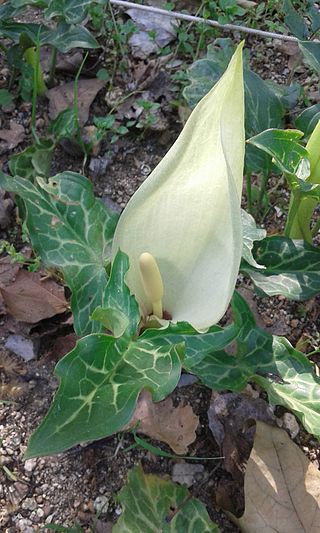
Arum italicum is a species of flowering herbaceous perennial plant in the family Araceae, also known as Italian arum and Italian lords-and-ladies. It is native to the British Isles and much of the Mediterranean region, the Caucasus, Canary Islands, Madeira and northern Africa. It is also naturalized in Belgium, the Netherlands, Austria, Argentina, North Island New Zealand and scattered locations in North America.
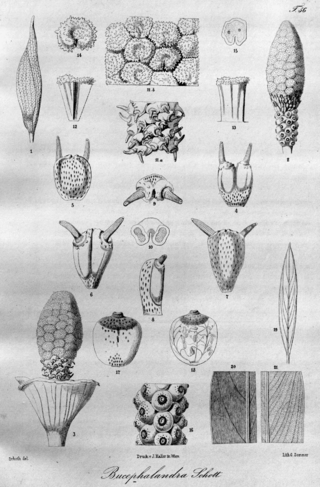
Bucephalandra is a genus of flowering plants in the family Araceae. There are 30 species of Bucephalandra which have been discovered in Borneo and have been formally described by S.Y. Wong and P.C. Boyce. Most of the species are found in Borneo. Bucephalandra are usually found growing as dense mats over stones or rocks in streams or rivers in moist tropical forest.
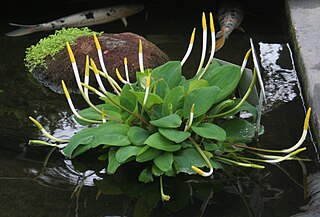
Orontium aquaticum, sometimes called golden-club, floating arum, never-wets or tawkin, is a species of flowering plants in the family Araceae. It is the single living species in the genus Orontium, which also contains several extinct species described from fossils. O. aquaticum is endemic to the eastern United States and is found growing in ponds, streams, and shallow lakes. It prefers an acidic environment. The leaves are pointed and oval with a water repellent surface. The inflorescence is most notable for having an extremely small almost indistinguishable sheath surrounding the spadix. Very early in the flowering this green sheath withers away leaving only the spadix.

Lagenandra is a genus of flowering plants in the family Araceae. It is endemic to the Indian Subcontinent. The genus is similar to Cryptocoryne, but can be distinguished from it by its involute vernation. Cryptocoryne on the other hand exhibit convolute vernation.

Piptospatha is a genus of flowering plants in the family Araceae. The genus is characteristic is rheophytic and has seeds that are dispersed by splashes of water hitting its cup-like spathes. It is native to Southeast Asia.
- Piptospatha burbidgei(N.E.Br.) M.Hotta - Sarawak, Sabah
- Piptospatha elongata(Engl.) N.E.Br. - Kalimantan Barat
- Piptospatha impolitaS.Y.Wong, P.C.Boyce & Bogner - Sarawak
- Piptospatha insignisN.E.Br. - Sarawak
- Piptospatha manduensisBogner & A.Hay - Kalimantan Timur
- Piptospatha marginata(Engl.) N.E.Br. - Sarawak
- Piptospatha perakensis(Engl.) Ridl. - southern Thailand, Peninsular Malaysia
- Piptospatha remiformisRidl. - Sarawak
- Piptospatha repensH.Okada & Tsukaya - Kalimantan Barat
- Piptospatha ridleyiN.E.Br. ex Hook.f. - Johor, Pahang, Selangor
- Piptospatha truncata(M.Hotta) Bogner & A.Hay - Sarawak
- Piptospatha viridistigmaS.Y.Wong, P.C.Boyce & Bogner - Sarawak

Arum dioscoridis, commonly known as the Spotted arum, is a plant of the arum family (Araceae).
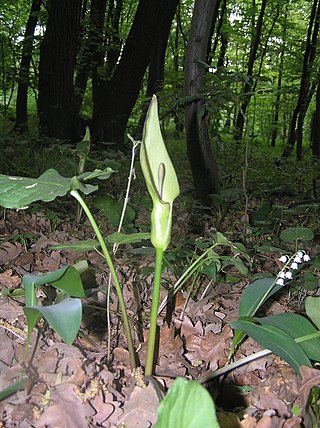
Arum cylindraceum is a woodland plant species of the family Araceae. It is found in most of Europe except the UK, Russia, Ukraine, Belarus, the Baltic States and Scandinavia, and in Turkey. It is also missing in northwestern France and southern Italy.

Arum orientale is a woodland plant species of the family Araceae. It is found in southeastern Europe as far west as Vienna and in Turkey. Its primary range is Romania, Bulgaria, and southern Ukraine.
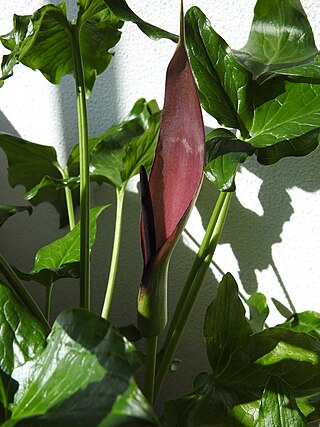
Arum sintenisii, known as Sintenis arum, is a flowering plant species in the family Araceae.
Arum italicum subsp. canariense is a flowering plant subspecies in the family Araceae.
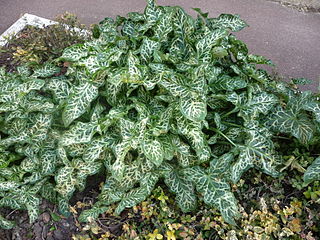
Arum italicum subsp. italicum is a flowering plant subspecies in the family Araceae.

Arum concinnatum, commonly known as the Crete arum, is a flowering plant species in the family Araceae.
Arum apulum, known as Apulian arum, is a flowering plant species in the family Araceae.
Arum byzantinum is a species of flowering plant in the family Araceae. It was described in 1836.

Anthurium obtusum is a species of plant in the genus Anthurium widely distributed in Central and South America, from Belize to Bolivia. The species was originally described as Anthurium trinerve by Adolf Engler and then in 1997, reclassified. The species is easily confused with Anthurium scandens, but can be distinguished by its terrestrial growth habit and a white spathe which stays erect rather than reflexed.
















